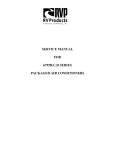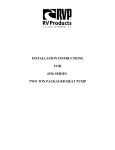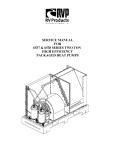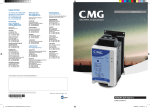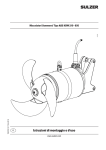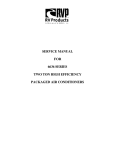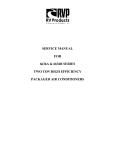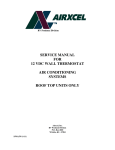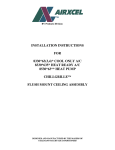Download RV Products 6536-A SERIES Service manual
Transcript
SERVICE MANUAL FOR 6536 “-” AND “A” SERIES TWO TON PACKAGED HEAT PUMPS TABLE OF CONTENTS 1. 2. 3. 4. 5. 6. 7. 8. 9. 10. 11. 12. 13. 14. 15. 16. 17. 18. 18A. 19. 19A. 20. 21. Warnings . . . . . . . . . . . . . . . . . . . . . . . . . . . . . . . . . . . . . . . . . . . . . . . . . . . . . . . . . . . . . . . . . . Accessibility Of Appliance . . . . . . . . . . . . . . . . . . . . . . . . . . . . . . . . . . . . . . . . . . . . . . . . . . . . Unit Dimensions And Specifications . . . . . . . . . . . . . . . . . . . . . . . . . . . . . . . . . . . . . . . . . . . . Specifications And Unit Identification . . . . . . . . . . . . . . . . . . . . . . . . . . . . . . . . . . . . . . . . . . Unit Depiction Figures . . . . . . . . . . . . . . . . . . . . . . . . . . . . . . . . . . . . . . . . . . . . . . . . . . . . . . . Thermostat Specifications . . . . . . . . . . . . . . . . . . . . . . . . . . . . . . . . . . . . . . . . . . . . . . . . . . . . Wall Thermostat - 6536-335* . . . . . . . . . . . . . . . . . . . . . . . . . . . . . . . . . . . . . . . . . . . . . . . . . Thermostat Control Panel . . . . . . . . . . . . . . . . . . . . . . . . . . . . . . . . . . . . . . . . . . . . . . . . . . . . Blower Performance Chart . . . . . . . . . . . . . . . . . . . . . . . . . . . . . . . . . . . . . . . . . . . . . . . . . . . Indoor Blower Motor Removal . . . . . . . . . . . . . . . . . . . . . . . . . . . . . . . . . . . . . . . . . . . . . . . . Outdoor Blower Motor Removal . . . . . . . . . . . . . . . . . . . . . . . . . . . . . . . . . . . . . . . . . . . . . . . By Flow Restrictor Replacement . . . . . . . . . . . . . . . . . . . . . . . . . . . . . . . . . . . . . . . . . . . . . . . Evaporator Coil Replacement . . . . . . . . . . . . . . . . . . . . . . . . . . . . . . . . . . . . . . . . . . . . . . . . . . Condenser Coil Replacement . . . . . . . . . . . . . . . . . . . . . . . . . . . . . . . . . . . . . . . . . . . . . . . . . . Compressor Replacement . . . . . . . . . . . . . . . . . . . . . . . . . . . . . . . . . . . . . . . . . . . . . . . . . . . . . Reversing Valve Replacement . . . . . . . . . . . . . . . . . . . . . . . . . . . . . . . . . . . . . . . . . . . . . . . . . . Wiring Diagram - Electronic Thermostat . . . . . . . . . . . . . . . . . . . . . . . . . . . . . . . . . . . . . . . . Wiring Diagram . . . . . . . . . . . . . . . . . . . . . . . . . . . . . . . . . . . . . . . . . . . . . . . . . . . . . . . . . . . . . Wiring Diagram . . . . . . . . . . . . . . . . . . . . . . . . . . . . . . . . . . . . . . . . . . . . . . . . . . . . . . . . . . . . . Wirebox Component Checkout (6536 Models) . . . . . . . . . . . . . . . . . . . . . . . . . . . . . . . . . . . . Wirebox Component Checkout (6536A Models) . . . . . . . . . . . . . . . . . . . . . . . . . . . . . . . . . . . Service Problems And Possible Solutions . . . . . . . . . . . . . . . . . . . . . . . . . . . . . . . . . . . . . . . . . Electrical Flow Charts . . . . . . . . . . . . . . . . . . . . . . . . . . . . . . . . . . . . . . . . . . . . . . . . . . . . . . . . A. Cooling Mode . . . . . . . . . . . . . . . . . . . . . . . . . . . . . . . . . . . . . . . . . . . . . . . . . . . . . . . . B. Heating Mode . . . . . . . . . . . . . . . . . . . . . . . . . . . . . . . . . . . . . . . . . . . . . . . . . . . . . . . . 2 2 3 4 5 6 7 10 11 12 13 16 17 18 18 18 19 20 21 22 23 24 25 26 34 1. WARNINGS IMPORTANT NOTICE WARNING - SHOCK HAZARD These instructions are for the use of qualified individuals specially trained and experienced in installation of this type equipment and related system components. To prevent the possibility of severe personal injury or equipment damage due to electrical shock, always be sure the electrical power to the appliance is disconnected. Installation and service personnel are required by some states to be licensed. PERSONS NOT QUALIFIED SHALL NOT INSTALL NOR SERVICE THIS EQUIPMENT. CAREFULLY FOLLOW ALL INSTRUCTIONS AND WARNINGS IN THIS BOOKLET TO AVOID DAMAGE TO THE EQUIPMENT, PERSONAL INJURY OR FIRE. NOTE WARNING The words “Shall” or “Must” indicate a requirement which is essential to satisfactory and safe product performance. Improper installation may damage equipment, can create a hazard and will void the warranty. The use of components not tested in combination with these units will void the warranty, may make the equipment in violation of state codes, may create a hazard and may ruin the equipment. The words “Should” or “May” indicate a recommendation or advice which is not essential and not required but which may be useful or helpful. 2 2. ACCESSIBILITY OF APPLIANCE The accessibility of this appliance will vary from one installation to another. It shall be left to the service technicians judgement, the best method of attaining access to perform service. 3. UNIT DIMENSIONS AND SPECIFICATIONS PACKAGE AIR CONDITIONER MODEL NUMBER BREAKDOWN FOLLOWS: 6 5 3 6 - 8 9 Revision Letter Model Series 6 - Panasonic Compressor(s) 7 - Sanyo Compressor(s) 8 - Tecumseh Compressor(s) 3 1 4. UNIT SPECIFICATIONS AND IDENTIFICATION 4 5. UNIT DEPICTION FIGURES 5 6. THERMOSTAT SPECIFICATIONS THERMOSTAT - 6795B3451 SUB-BASE - 7330-3401 SET TEMP. RANGE: 55 TO 90 DEGREES F. DISPLAY TEMPERATURE: -20 TO 160 DEGREES F. SCALE: DEGREES FAHRENHEIT DISPLAY FORMAT: LIQUID CRYSTAL DISPLAY RESOLUTION: ONE DEGREE F. ACCURACY: ± 2% OF DISPLAY TEMPERATURE RANGE SAMPLING RATE: EVERY 30 SECONDS POWER SOURCE: 12 VDC NON-REGULATED, NON-FILTERED ± 2 VOLTS OPERATING TEMPERATURE: -10 TO +55 DEGREE C. OUTPUT LOAD: 40 mA MINIMUM TO 1.5 AMP MAXIMUM FOR EACH OUTPUT SAFEGUARDS: STATIC ELECTRICITY PROTECTION TO END USER AFTER INSTALLATION ANTI-STATIC PACKAGING TO BE USED FOR SHIPMENT SPIKE PROTECTION TO 400 VDC ON R+ TERMINAL CONFORMAL COATING ON P.C. BOARD PROTECTION FROM MOISTURE DEFAULT MODE: WHEN THE THERMOSTAT IS SWITCHED TO HEAT AND ELECTRIC HEAT IS SELECTED ON THE SUB-BASE, AND THE OUTDOOR TEMPERATURE FALLS TO A POINT AT WHICH THE HEAT PUMP SHUTS DOWN (USUALLY BETWEEN 25 - 40 DEGREES), THE SUB-BASE WILL AUTOMATICALLY ALSO CALL FOR GAS FURNACE OPERATION IF THE INDOOR TEMPERATURE DROPS TO 45 DEGREES. GAS FURNACE OPERATION WILL SHUT OFF AT 60 DEGREES. THE USER SHOULD SWITCH THE SUB-BASE TO GAS HEAT IF THIS OCCURS. GENERAL INFORMATION A. Air Conditioner This packaged heat pump mounts below the floor of the vehicle. The innovative design makes it possible to maintain a smooth, free-flowing roof line for the vehicle. It also relocates all noise and condensate drainage off the roof to below the floor of the vehicle. 1) The thermostat is demanding cooling or electric heating, 2) The vehicle is being powered by either shore line or the on-board generator. 2nd stage (the second compressor and refrigeration circuit), will operate when: The heat pump contains a dual compressor system. It combines the capacity of two roof mounted units into one highly efficient and compact package. Each compressor is connected to a separate refrigeration circuit. The system can be operated with a single compressor when the air conditioning requirement is low, or with two compressors when maximum performance is required. This heat pump operates a two-stage system. The first compressor and refrigeration circuit is referred to as “1st Stage”. The second compressor and refrigeration circuit is referred to as “2nd Stage”. First and second stage will operate as indicated below. 1) The thermostat senses room temperature that is 2 degrees or higher than the setpoint temperature on the thermostat, 2) The vehicle is being powered by the on-board generator. Shore line by itself will not provide enough power to operate both first and second stage unless 50 amp service is available. Switching and control of 1st and 2nd stage cooling is automatic. When operating from shore line, the system automatically limits operation to 1st stage only unless 50 amp service is available. When the shore line is plugged into the on-board generator, the system automatically allows for operation of both 1st and 2nd stage units. However, if when powering both 1st stage (the first compressor and refrigeration circuit), will operate when: 6 systems from the on-board generator and the cooling demand does not require that both systems operate, stage two will shut down leaving stage one in operation. Heat operation always energizes both stages, however, only stage one operates if power is not available to circuit #2. B. the compressors. This is to allow time for generators to stabilize when initially starting. The balance of the delay (2.5 minutes) occurs when the compressors cycle off. This is to allow time for the air conditioner pressures to balance before restarting. This delay will eliminate problems associated with short cycling and will extend equipment life. There is thirty seconds and two degrees between 1st and 2nd stage cooling. The thermostat will not call for 2nd stage cooling until room temperature rises 2 degrees above the 1st stage starting temperature. Once the thermostat calls for 2nd stage cooling, a 30 second delay is incurred to prevent both stages from starting together. Thermostat This thermostat is designed to operate 12 VDC controlled heating and air conditioning systems. It can control one stage of heating and two stages of cooling. It is a manual changeover type of thermostat between heating and cooling. Manual changeover indicates that the operator must manually switch the thermostat from cooling operation to heating. The thermostat will not make this change automatically. It also incorporates time delay circuitry. The user selectable heating mode on the sub-base allows gas heat control or heat pump operation. The operating setpoints are changeable to suit the comfort needs of the occupants. Instructions for setting operating temperatures (the setpoints) are covered in “Adjusting Setpoint”. The time delays amount to 3 minutes between off and on cycles. Thirty seconds of this time delay is at the turn on of 7. WALL THERMOSTAT - 6536-335* A. APPLICATION The 6536-335* thermostat is intended for use with an RV Products 2 stage heat pump. receptacle for the 3 pin plug. RV Products suggests the thermostat wiring be minimum 18 gauge. The furnace control circuit must not exceed 1 amp. The thermostat is equipped with a replaceable fast-acting 2 amp fuse located on the base of the thermostat. The fuse is designed to “open” if the furnace is mis-wired or if there is a short in the system. Before replacing fuse, the cause of the failure must be located and corrected. The thermostat connects to the heat pump with a 9 pin plug through a lifeline (RVP part number 6795C4351). The OEM (Original Equipment Manufacturer) must supply the 12 VDC wiring and the furnace control wiring which connects to the 3 pin plug on the thermostat. The OEM supplies the mating B. OPERATION The display indicates room temperature and the word ROOM is shown on the LCD until the temperature selector is pressed; at which time the display temporarily indicates the setpoint temperature and the word SET is shown on the LCD. Each time the UP arrow is pressed, the setpoint will increase. Each time the DOWN arrow is pressed, the setpoint will decrease. Once the temperature selector button is no longer pressed for a few seconds, the room temperature will again be displayed, and the word ROOM will be displayed on the LCD. In the electric heat mode, if the heat pump is unable to satisfy the thermostat, the heat pump goes into lockout. DIFF will display on the thermostat LCD indicating backup heating is required to satisfy the thermostat. 7 In gas heat mode, the gas furnace will provide the only source of heat and the heat pump is locked out. NOTE The temperature displays in degrees Fahrenheit as a factory set default (See Figure 2). To display in degrees Celsius, move the jumper marked “F” and “C” to bridge between middle pin and position “C”, then cycle 12 volt power off and then back on. WIRING THE WALL THERMOSTAT OEM must supply these mating parts to connect these thermostats per Figure 1. The plugs must be connected to motorcoach wiring harness before the base is secured to the wall. Heat Pump Example To Bring On Gas Furnace As Backup Heat Setpoint 70 \\\ Indoor Temp. 70+ 69 71 69 65 71 69 65 71 69 71 \\\ 69 65 71 \\\ 69 71 Operation No functions occur Heat Pump turns on (Primary heat source) Heat Pump turns off (Thermostat satisfied) Heat Pump turns on Gas Furnace turns on, Heat Pump turns off (Heat Pump not able to satisfy Thermostat) (First strike for backup heat counter) Gas Furnace turns off (Thermostat satisfied) Heat Pump turns on Gas Furnace turns on, Heat Pump turns off (Heat Pump is again unable to satisfy Thermostat), (Backup heat counter reaches 3rd strike and Heat Pump is locked out for 2 hours), backup heat counter is reset if Heat Pump is running for more than 20 minutes and does not call for backup heat Gas Furnace turns off (Thermostat satisfied) Gas Furnace turns off (Becomes Primary heat source) Gas Furnace turns off (Thermostat Satisfied) After 2 hour lockout Heat Pump turns on (Resumes as Primary heat source) Gas Furnace turns on, Heat Pump turns off (Becomes Primary heat source) (Heat Pump is locked out for another 2 hours) Gas Furnace turns off (Thermostat Satisfied) After 2 hour lockout Heat Pump turns on (Resumes as Primary heat source) Heat Pump turns off (Thermostat Satisfied) (Backup heat counter is reset any time Heat Pump satisfies thermostat setpoint and does not need Gas Furnace) The word “DIFF” will display on LCD when backup heat is operating and the heat pump is locked out. There is a 30 second delay between Stage 1 and Stage 2. There is also a 3 minute anti-short cycle delay time for cooling. The chart below shows the system functions with the 6536-335* thermostat. After the entire air conditioning system (and furnace system) is installed, check each position function. 8 6536-335* 2-STAGE HEAT PUMP WITH BACKUP HEAT THERMOSTAT OPERATION TABLE Mode Switch Fan Mode Switch Fan Speed Switch Calling 1 Cool Auto Lo No 2 Cool Auto Lo Stage 1 1 Degree Above Set ID fan low, compressor #1 and OD blower low cycle as needed 3 Cool Auto Lo Stage 2 2 Degrees Above Set ID fan low, compressors #1 and #2 and OD blower high cycle as needed 4 Cool On Lo No 5 Cool On Lo Stage 1 1 Degree Above Set ID fan low continuous, compressor #1 and OD blower low cycle as needed 6 Cool On Lo Stage 2 2 Degrees Above Set ID fan low continuous, compressors #1 and #2 and OD blower high cycle as needed 7 Cool Auto Hi No 8 Cool Auto Hi Stage 1 1 Degree Above Set ID fan high, compressor #1 and OD blower low cycle as needed 9 Cool Auto Hi Stage 2 2 Degrees Above Set ID fan high, compressors #1 and #2 and OD blower high cycle as needed 10 Cool On Hi No 11 Cool On Hi Stage 1 1 Degree Above Set ID fan high continuous, compressor #1 and OD blower low cycle as needed 12 Cool On Hi Stage 1 2 Degrees Above Set ID fan high continuous, compressors #1 and #2 and OD blower high cycle as needed 13 Off Auto Lo or Hi No No functions occur in this mode 14 Off On Lo No ID fan low continuous 15 Off On Hi No ID fan high continuous 16 Gas Heat Auto or On Lo or Hi No No functions occur in this mode 17 Gas Heat Auto or On Lo or Hi Stage 1 Heater will be energized to run 18 Gas Heat Auto or On Lo or Hi Stage 2 There is no provision for 2nd stage heat when operating in the gas heat mode 19 Elec Heat Auto or On Lo or Hi No 20 Elec Heat Auto or On Lo or Hi Stage 1 Heat pump will run ID fan high, both compressors, OD fan high and both reversing valves 21 Elec Heat Auto or On Lo or Hi Stage 2 Backup heater will be energized to run 9 Operation No functions occur in this mode ID fan low continuous No functions occur in this mode ID fan high continuous No functions occur in this mode 8. THERMOSTAT CONTROL PANEL A. OPERATION Your air conditioner is operated from the control panel located on the electronic wall mounted thermostat. When the furnace is connected to this thermostat, it will be operated from the same control panel. 3. Identification and operational descriptions for all control panel switches and display are listed below: 1. 2. Liquid Crystal Display - We will start with the display because the display will be visible any time the system is in operation. The display will remain visible while the thermostat is on and powered. Cooling Fan Switch - The fan switch has four positions from which to control the operation of the cooling blower. The fan switch controls operation of the cooling blower only after the system switch is placed into the COOL position. With the system switch in any other position, the fan switch will have no effect on the operation of the cooling blower. Fan switch positions and their resulting function are listed below: HIGH AUTO - When in the high automatic position, the cooling blower operates at high speed and cycles off and on with the 1st stage compressor. 2nd stage cooling will cycle on and off as needed having no effect on cooling blower operation. System Switch - The system switch has four positions to control the operation of the heating and air conditioning systems. They are as follows: LOW AUTO - When in the low automatic position, the cooling blower operates at low speed and cycles off and on with the 1st stage compressor. 2nd stage cooling will cycle on and off as needed having no effect on cooling blower operation. COOL - When in the cool position, 1st and 2nd stage cooling will cycle from the cooling system setpoint. Blower operation will be controlled by the position of the Cooling Fan Switch. HEAT - When in the heat position, the heating system will cycle from the heating system setpoint. Heat will be by electricity (heat pump) or gas as selected on sub-base. The gas heating blower will operate per the heating system manufacturer specifications. LOW ON - When in the low on position, the cooling blower operates continuously at low speed. Stage 1 and Stage 2 compressors cycle on and off as needed. HIGH ON - When in the high on position, the cooling blower operates continuously at high speed. Stage 1 and Stage 2 compressors cycle on and off as needed. OFF - When in the off position, no thermostat or system operation will occur. During heat pump operation, the blower operates at high speed with heat demand. FAN - When in the fan position, the cooling blower will operate continuously at high speed. 10 B. TESTING Place the thermostat system switch into the “OFF” position. Once all safety precautions have been met, reinstate power to all systems; thermostat, cooling and heating. COOLING Move the system switch to COOL. The display will indicate room temperature. Adjust the setpoint above room temperature. Move the fan switch to LOW ON. The fan operates continuously at low speed. OFF Starting with the system switch in the OFF position, the display will be blank and no part of either the cooling or heating systems will be operating. Move the fan switch to HIGH ON. The fan operates continuously at high speed. Move the fan switch to LOW AUTO, the fan will stop. Move the fan switch to HIGH AUTO, the fan will remain off. FAN Move the system switch to FAN. The display indicates room temperature. The cooling system fan operates continuously at high speed. No other components or systems are operating. Adjust the setpoint 5 degrees below room temperature (if the thermostat has been powered for more than 3 minutes, 1st stage cooling and the cooling fan will come on approximately 1 minute later). If the thermostat has not been powered for more than 3 minutes, 1st stage cooling and the cooling fan will come on anywhere from 30 seconds to 3 minutes later. 2nd stage cooling will come on approximately 30 seconds after the 1st stage. HEATING Move the system switch to HEAT. The display will indicate room temperature. Adjust the setpoint of the thermostat above the room temperature displayed. After 15 to 30 seconds, the heat circuit of the thermostat will activate the heating controls. Once the heat has turned on and is running, adjust the setpoint below the room temperature displayed. After 15 to 30 seconds, the heat circuit of the thermostat will turn off and deactivate the heating controls. In heat pump operation, indoor fan operates on only high speed . With the fan switch in HIGH AUTO, the fan will operate at high speed and cycle with stage 1 compressor. Move the fan switch to LOW AUTO. The fan will operate at low speed and cycle with stage 1 compressor. Once both stages of cooling and both fan speeds have been verified, adjust setpoint 1 degree below room temperature. After 15 to 30 seconds, 2nd stage cooling will turn off while 1st stage remains on. 9. PACKAGED AIR CONDITIONER BLOWER PERFORMANCE DATA TEST CONDITION: 115 VAC, 60 HZ, 1 PHASE, DRY COIL CHART 1 11 10. INDOOR BLOWER MOTOR REMOVAL 1. Remove indoor blower access panel. 5. Remove motor assembly from scroll. 2. Disconnect wiring from motor terminal block and capacitor. 6. Remove blower wheel and motor mounting bracket. 3. Remove 4 screws from venturi (See #1, Figure 7). 4. Remove 3 screws from motor mount bracket (See #2, Figure 7). Note: Upon reassembly, the references made on Figures 7 and 8 shall be used for proper reassembly. SIDE VIEW Section 1. Position motor with terminal block parallel to motor mount leg opposite motor clamp. Assemble motor mount into scroll in orientation shown. Section 2. Torque nut to 65 in. lbs. min. Section 3. Ground wire terminal assemblies between screw head and washer. Section 4. Motor rotation wires to be connected: Yellow to Yellow and Orange to Orange. Section 5. Alternate capacitor: 1499-546 Section 6. Bundle the rotation and capacitor wires up and wire tie together. 12 END VIEW 1. Wheel must be mounted with a minimum of 5/16" clearance to scroll sides. 2. Apply grease to motor shaft before assembling wheel. 3. Torque set screw on flat of shaft to 110 #10 in. lbs. 11. OUTDOOR BLOWER MOTOR REMOVAL 1.It will be necessary to remove the top panel of the unit. 6. Remove 4 screws from venturi (See #1, Figure 10). 1. Remove 4 screws that attach scroll housing to basepan (See #1, Figure 9). 7. Remove 4 screws from motor mount bracket (See #2, Figure 10). 2. Disconnect wiring from motor terminal block. 8. Remove motor assembly from scroll. 3. Remove scroll/motor assembly from the unit. 9. Remove blower wheel and motor mounting bracket. 4. If at this point only the blower wheel needs replaced, then remove 4 screws from inboard venturi. Remove and replace blower wheel (see note) or else go to Step 6. Note: Upon reassembly, the references made on Figures 9 and 10 shall be used for proper reassembly. 5. Disconnect wiring at capacitor. 13 BOTTOM VIEW 1. Wheel must be mounted with a minimum of 1/4" clearance to both venturis. 2. Apply grease to motor shaft before assembling wheel. 3. Torque set screw on flat of shaft to 110 #10 in. lbs. 14 SIDE VIEWS 1. Position motor with terminal block opposite motor mount clamp. 2. Torque nut to 65 in. lbs. min. 3. Ground wire terminal assembles between screw head and washer. Wrap wire around motor mount leg to take up slack. 4. Wire tie capacitor wires to mount leg. 15 12. BY-FLOW RESTRICTOR REPLACEMENT 1. Remove top panel. 2. Remove Section C (See Figure 11). 3. Remove outdoor blower. Follow steps 1-4 in Outdoor Blower Motor Removal Section. 4. Be certain at this point that the refrigerant charge has been removed from the system/systems being serviced. 5. Remove clamps holding restrictor in place (See #17, Figure 12). 6. Unbraze by-flow restrictor from points 16. Make note of plumbing locations for new restrictor. Must be installed in same manner. (Note to protect any wiring that could come into contact with the torch flame or heated copper lines.) Note: 16 Upon reassembly, the references made on Figures 11 and 12 shall be used for proper reassembly. The assemblies shall be secured with wire ties in order to prevent excess chafing and vibration. 13. INDOOR COIL REPLACEMENT 1. Refer to Outdoor Coil Replacement (Steps 1 through 7). 2. Remove screws from bottom of step panel (See #6, Figure 12). 3. Remove freeze thermister located on indoor blower side of evaporator coil (pull top of indoor blower assembly outward if necessary). 4. Pull step panel slightly off to one side. 5. Unbraze refrigerant from points (See #1 and #5, Figure 12). Protect wiring and insulation from torch flame. 6. Remove screws (See #7, #8 & #9, Figure 12). Evaporator coil can now be removed. Note: 17 Upon reassembly, the references made on Figures 11 and 12 shall be used for proper reassembly. The assemblies shall be secured with wire ties in order to prevent excess chafing and vibration. If additional sealant is needed to seal coil header to drain pan (notched end), a silicone or perma-gum sealant is adequate. Do not use solvent base sealers that would harm the ABS plastic drain pan. 14. OUTDOOR COIL REPLACEMENT 1. Remove top panel. 2. Remove screws along wirebox side of coil (See #10, Figure 12). 3. Remove corner panel (See Section C, Figure 11). 4. Be certain at this point that the refrigerant charge has been removed from the systems. 5. Make note of plumbing locations. The plumbing will have to go back to the same locations on the new coil. 6. Unbraze discharge and liquid lines at points #2 and #4, Figure 12. 7. Remove freeze thermister. 8. Remove condenser coil. 15. COMPRESSOR REPLACEMENT 1. Remove compressor access panel. 7. Unbraze plumbing at points #11 and #12, Figure 12 (protect any wiring and insulation from torch flame). 2. The top panel may be removed at this point if it allows technician better access to perform service. 8. Remove mounting nuts and washers (See #14, Figure 12). Remove refrigerant charge from system/systems being serviced. 9. Remove compressor from unit. 3. 4. Remove terminal caps (See #13, Figure 12). 5. Remove wiring from compressor terminal block (cut wire ties on suction line). 6. Remove reversing valve clamp from compressor. Note: 16. REVERSING VALVE REPLACEMENT 1. Remove compressor access panel. 2. Remove top panel at this point. 3. Remove refrigerant charge from system/systems being serviced. 4. Remove outdoor blower. See Outdoor Blower Removal Steps 1-4 on page 11. 5. Remove reversing valve solenoid. 6. Unbraze plumbing points at 1, 2, 3 & 4 in Figure 13 (Protect wiring). 7. Remove reversing valve from bracket. 8. When reinstalling reversing valve, wrap the valve body with a wet rag as best you can. 18 Upon reassembly, compressor wires shall be wire tied to suction lines to prevent excess chafing. 17. WIRING DIAGRAMS - THERMOSTAT Diagram 1976E119 Electronic Wall Thermostat Assembly (12 VDC) - 6536-3451 Thermostat plug positions on the p.c. board. If no voltage is detected at the p.c. board connector, check for voltage at the thermostat. Note: All functions of this heat pump are subject to thermostat time delays according to the operation manual. 19 18. WIRING DIAGRAM 6536 Series Two Ton Packaged Heat Pump - 2 Compressor 20 18A. WIRING DIAGRAM 6536A Series Two Ton Packaged Heat Pump 21 19. WIREBOX COMPONENT CHECKOUT 6536 “-” MODEL 22 19A. WIREBOX COMPONENT CHECKOUT 6536 “A” MODELS 23 20. SERVICE PROBLEMS AND POSSIBLE SOLUTIONS COOLING MODE Problems Possible Solutions 1. Nothing Runs - Cooling Mode No A/C Voltage, No 12 VDC, Thermostat, Wiring, P.C. Board 2. IDFM Runs, No Compressor, No ODFM Cooling Freeze Thermistor - (Insufficient Indoor Air Flow), Thermostat, Wiring, Compressor, Contactor, P.C. Board 3. IDFM Runs, ODFM Runs, No Compressor Insufficient Voltage To Unit, Run Capacitor, Start Device, Overload, Wiring, Compressor 4. IDFM Runs, Compressor Runs, No ODFM 5. Compressor Runs, ODFM Runs, No IDFM 6. Compressor, ODFM, IDFM Runs, Insufficient Cooling 7. Compressor, ODFM, IDFM Runs, Unit Is Heating While In Cool Mode Run Capacitor, Fan Motor, P.C. Board, Wiring Thermostat, Run Capacitor, Wiring, Fan Motor, P.C. Board Air Flow Restriction, High Ambient Temperature, Undersized Refrigeration System, Very Little Or No Refrigerant Charge, Compressor Thermostat, Wiring, P.C. Board, Reversing Valve HEATING MODE Problems Possible Solutions 1. Nothing Runs - Heat Mode No A/C Voltage, No 12 VDC, Thermostat, Sub-base, Wiring, P.C. Board 2. IDFM Runs, No Compressor, No ODFM Heating Freeze Thermister, Low Outdoor Ambient Conditions, Wiring, Compressor, Contactor, P.C. Board 3. IDFM Runs, ODFM Runs, No Compressor Insufficient Voltage To Unit, Run Capacitor, Start Device, Overload, Wiring, Compressor 4. IDFM Runs, Compressor Runs, No ODFM Run Capacitor, Fan Motor, Wiring, P.C. Board 5. Compressor Runs, ODFM Runs, No IDFM Run Capacitor, Fan Motor, Wiring, P.C. Board 6. Compressor Runs, ODFM Runs, IDFM Runs, Insufficient Heating Air Flow Restriction, Low Ambient Temperature, Undersized Refrigeration System, Very Little Or No Refrigerant Charge, Compressors 7. Compressor, ODFM, IDFM, Unit Is Cooling While In Heat Mode Wiring, P.C. Board, Reversing Valve 24 21. ELECTRICAL FLOW CHARTS 6536 SERIES With the use of these flow charts, you will be able to quickly identify a non-working problem. Determine if the problem is high or low voltage and then solve the problem. To use these flow charts, start at the top left corner. Using a volt-ohm meter, check what is indicated in that box. If the answer to what is indicated is No, work horizontally until you find the problem. When the answer is Yes or OK, work the chart downward until you locate the problem. Do Not Move Downward on any chart until all preceding steps have been confirmed good. Do Not start in the middle of any chart without knowing everything previous (upward on the chart) is OK or you may replace the wrong part. IMPORTANT NOTICE When using a jumper wire to diagnose a low voltage problem, Never Short Any Positive Terminal to Ground or the Terminal Marked “B”. Serious thermostat or p.c. board damage may occur. 25 A. 6536 SERIES OPERATION SEQUENCE COOLING MODE 26 COOLING MODE CHECK/NO GREEN L.E.D. LIGHT FY/Y CIRCUIT TO THE THERMOSTAT Note: The green light on the 6536A model has some new functions: 1. 2. 3. If the light is on solid, then everything is OK. If the light is blinking slowly, the unit is in a 3 minute time delay. If the light is blinking fast, there is either no line voltage to Circuit #1 or one of the thermistors are open. 27 I.D. BLOWER LOW SPEED THERMOSTAT ON LOW FAN COOL ONLY Note: All operating functions subject to thermostat time delays. 28 I.D. BLOWER HIGH SPEED THERMOSTAT ON HIGH FAN COOL ONLY Note: All operating functions subject to thermostat time delays. 29 COMPRESSOR #1 CHECKOUT THERMOSTAT CALLING FOR COMPRESSOR COOLING ONLY Note: All operating functions subject to thermostat time delays. 30 COMPRESSOR #2 CHECKOUT THERMOSTAT CALLING STAGE 2 COOLING ONLY Note: All Operating Functions Subject To Thermostat Time Delays 31 CHECKOUT OUTDOOR BLOWER LOW SPEED HEATING AND COOLING MODES 32 CHECKOUT OUTDOOR BLOWER HIGH SPEED HEATING AND COOLING MODES 33 B. 6536 SERIES OPERATION SEQUENCE HEATING MODE 34 HEAT/MODE CHECKOUT/NO GREEN L.E.D. LIGHT F/F CIRCUIT TO THE THERMOSTAT 35 HEAT MODE I.D. BLOWER CHECKOUT Note: High Fan Speed Is Energized Only. All Operating Functions Subject To Thermostat Time Delays. 36 COMPRESSOR #1 CHECKOUT HEAT MODE Note: All Operating Functions Subject To Thermostat And P.C. Board Time Delays. Sub-base Must Be In The Electric Mode. 37 HEAT PUMP COMPRESSOR #2 CHECKOUT (HEAT MODE) Note: All Operating Functions Subject To Thermostat And P.C. Board Time Delays. Sub-base Must Be In Electric Mode. 38 REVERSING VALVE CHECKOUT HEAT MODE Note: Reversing Valve Is Energized In The Heat Mode And Is Subject To Thermostat And P.C. Board Time Delays. Note: If Compressor And Fan Motors Not Running, Refer To Proper Checkouts. Once The Reversing Valve Has Energized, The P.C. Board Locks The Valve Into An Energized Position Until The Wall Thermostat Is Put In The Cool Position And Actually Has A Demand For Cooling, Sending 12 VDC Down Y1. 39 RV Products A Division of Airxcel, Inc. P.O. Box 4020 Wichita, KS 67204 1976C281 (8-05) PP








































